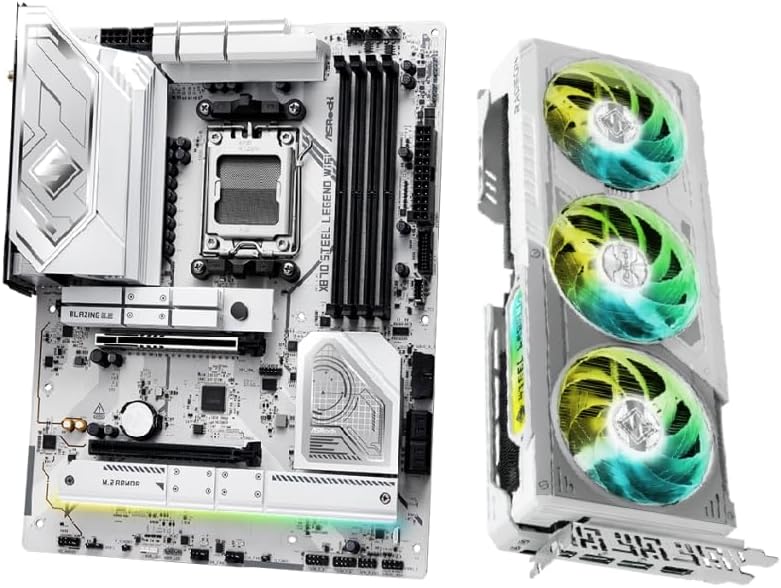Early Amazon Spring Sale GPU deals 2025

Table of Contents
With Amazon’s Spring Sale just around the corner, it’s the perfect time to grab one of the best graphics cards from AMD, Nvidia, or even maybe Intel, all without breaking the bank. There have been some major graphics card launches this year already, potentially meaning we could see some huge savings on the previous generation models. These high-performance GPUs deliver smooth gaming in every resolution, catering to budget gamers up to the 4K elite. The latest GPUs bring lightning-fast ray tracing and seamless VR experiences. We’ve rounded up some of our favorites, from powerhouse models to more budget-friendly options, all at fantastic prices.
Best Amazon Spring Sale graphics card deals

XFX Swift AMD RX 9060 XT OC (16GB White Edition)

ASUS SFF-Ready Prime GeForce RTX 5060

XFX Swift AMD Radeon RX 9070 XT

Sapphire Pulse AMD RX 9070 XT

GIGABYTE Radeon RX 9060 XT Gaming OC 8G Graphics Card

PNY GeForce RTX 5070 ARGB Overclocked

ASRock Steel Legend RX 9070 XT 16GB and X870 WiFi AM5 Motherboard Bundle
When do Amazon Spring Sale Graphics Card Deals Start?
The sale started on March 20th last year, coming to an end on March 25th. While the sales for 2025 are yet to be announced we think they will be featured at a similar time. New deals will be appearing all the time throughout this period so make sure to keep coming back to check on the latest ones. We’ll be keeping this page updated the best we can as new deals are applied and old ones are removed.
Prime Day is finally here! Find all the biggest tech and PC deals below.
- Sapphire 11348-03-20G Pulse AMD Radeon™ RX 9070 XT Was $779 Now $739
- AMD Ryzen 7 7800X3D 8-Core, 16-Thread Desktop Processor Was $449 Now $341
- ASUS RTX™ 5060 OC Edition Graphics Card Was $379 Now $339
- LG 77-Inch Class OLED evo AI 4K C5 Series Smart TV Was $3,696 Now $2,796
- Intel® Core™ i7-14700K New Gaming Desktop Was $320.99 Now $274
- Lexar 2TB NM1090 w/HeatSink SSD PCIe Gen5x4 NVMe M.2 Was $281.97 Now $214.98
- Apple Watch Series 10 GPS + Cellular 42mm case Smartwatch Was $499.99 Now $379.99
- ASUS ROG Strix G16 (2025) 16" FHD, RTX 5060 gaming laptop Was $1,499.99 Now $1,274.99
- Apple iPad mini (A17 Pro): Apple Intelligence Was $499.99 Now $379.99
*Prices and savings subject to change. Click through to get the current prices.
Best Graphics Card Deals for Every Budget
Finding the right graphics card can be overwhelming, especially with so many models on the market. Whether you're a hardcore 4K gamer, an esports competitor, or a casual player looking for a good deal, there's something for everyone. To make things easier, we've broken down the best graphics cards into three key categories based on performance and price range.
For those who want cutting-edge performance, ray tracing, and high frame rates at 4K, these GPUs are the top picks:
- Nvidia RTX 4080 Super – Features DLSS 3 and AI-powered frame generation, making it one of the best options for smooth 4K gaming.
- AMD RX 7900 XTX – More VRAM (24GB) and raw power than the 4080, making it a great alternative for long-term futureproofing.
- RTX 4090 – If money is no object, this is the most powerful consumer GPU available, though overkill for most.
If you want a balance between performance and price, these GPUs excel at 1440p gaming with ultra settings and high refresh rates (120Hz-165Hz):
- RTX 4070 / 4070 Ti – Ideal for DLSS-enhanced gaming with ray tracing, offering excellent efficiency.
- RX 7800 XT – Better raw FPS performance per dollar compared to Nvidia's cards at this price.
- RTX 4060 Ti (8GB/16GB) – A cheaper alternative that still handles 1440p esports titles well.
If you're on a tight budget, these GPUs provide the best performance for 1080p gaming and light 1440p gaming:
- RTX 4060 – Best Nvidia budget option, offering great power efficiency and DLSS support.
- RX 7600 – AMD's strongest budget contender, offering solid 1080p performance for a lower price.
- Intel Arc A770 – A lesser-known but viable budget GPU, especially if you optimize driver settings.
Nvidia vs. AMD – Which Should You Buy During The Sales?
When shopping for a graphics card, the choice between Nvidia and AMD is one of the biggest decisions you'll make. Both companies offer powerful GPUs, but they cater to different priorities. With the most recent models your choice has become a little bit harder but with older generations Nvidia tends to be favored for features and performance and AMD for value.
- If you prioritize ray tracing, power efficiency, and AI features, go with Nvidia.
- If you want the best raw performance per dollar and longer VRAM support, go with AMD.
- If you mainly play eSports or non-ray-traced games, both brands perform similarly, so it comes down to pricing.
How to Find The Best GPU Deals During Amazon’s Spring Sale
Not all “discounts” are actually great deals, some retailers inflate prices before the sale just to make discounts look bigger. To avoid falling for fake deals, follow these tips:
- Before making a purchase, look up the GPU's price history using tools
- If your first-choice GPU isn't on sale, check for similar models
- Sometimes, bundled extras make a deal even better, so look out for free games bundled in, extended warranties, and free software subscriptions
Whether you're upgrading for 4K gaming, high refresh rates, or just the best performance per dollar, these insights will help you make the right choice without overspending.

